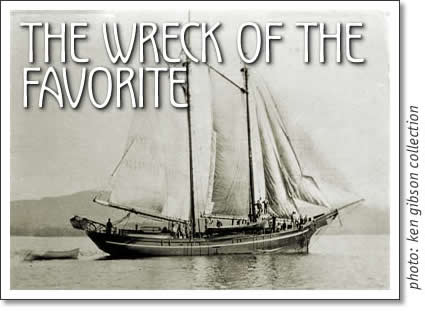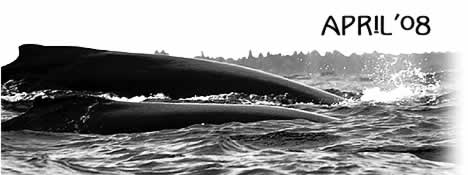
The Wreck of the Favorite
by David W. Griffiths, Tofino

A few weeks back I received a photograph from Tofino historian Ken Gibson. The image shows a schooner-rigged vessel towing a skiff, her crew on deck, along with what appears to be a Tla-o-qui-aht dugout canoe.Ken was wondering if she might be the Favorite; a sealing schooner that during the heyday of the pelagic seal hunt became a familiar sight on the waters of the Clayoquot and ultimately would end her days beneath them.
On May 16th 1868 the following notice appeared in the pages of Victoria's British Colonist:
"Those interested in the progress of Colonial shipbuilding will note the 125 ton schooner at the Hudson Bay Company's wharf for fitting out. She is the Favorite, built with red pine for Captain McKay who will also take command. The contractor was Mr. Burr, one of the best shipbuilders in the Colony".
Two months after that notice the Favorite was fitted-out and loaded with 120 tons of mixed cargo for her maiden voyage to Hawaii.
Fifty-seven days later she was back in Victoria.
So began a long and varied career in the freighting trade, with cargoes as various as her ports of call. Captain McKay was well pleased with his little ship.By 1875 McKay could afford to pay off his mortgage on the Favorite and sold off two-thirds of his shares to Captain Spring (recognized as the "father" of the local pelagic sealing industry) and his partner Captain Francis.
Later, Spring bought out McKay's share of the schooner and in between her freighting voyages entered her into the growing sealing trade.
During the 1880's sealing schooners from Victoria, Puget Sound and San Francisco stopped here in Clayoquot Sound to recruit Tla-o-qui-aht hunters for 6-9 month voyages to the Bering Sea, Siberia and the Sea of Japan.
Schooners such as the Favorite, Wanderer, Penelope and Venture became common sights in the Sound, their decks stacked with traditional Tla-o-qui-aht canoes.
The Tofino area was the last outpost for supplies and supported a branch office of the Victoria Sealing Company, where local buyers John Brice and James Sloman carried on a lucrative trade.
For First Nations, pelagic sealing became a major occupation and was their first real opportunity to earn a lot of money by the standards of the day.
Besides huge profits, the hunt generated some very colourful characters including Captain Victor Jacobsen, Captain George Heater, the Spring family and Captain Alexander McLean, who was the inspiration for Jack London's character "Wolf Larsen" in his novel "The Sea Wolf". McLean was skipper of the Favorite when she returned to Victoria in 1884 with 1700 seal skins aboard - the largest recorded catch to that date.
In the late 1880's the Favorite, along with others of the southern whaling fleet, began to have brushes with American Revenue Cutters striving to protect the seal's Aleutian Islands breeding areas from encroachment by foreign vessels. Schooners were seized, catches confiscated, vessels stripped and at times crews were left to make their own way home.
The Favorite continued with very successful voyages; in 1890 she returned to Victoria with 2000 skins, but by 1893, after agreements between the U.S. and Canada over seal protection regulations were ratified, the Victorians were forced to go far offshore towards Japan in order to make their voyages profitable. The Favorite continued sealing, but with greatly reduced catches.
In 1894 the Favorite was seized by the U.S. Revenue Cutter Mohican for carrying illegal firearms; namely a flare gun. The little schooner arrived home under seizure with 1247 pelts aboard, as well as an enraged Captain McLean who immediately filed an official complaint. The seizure of the Favorite became a test case for the international tribunal studying the claims of the sealers.
McLean eventually won damages from the Bering Sea Claim Commission, but the days of sealing were numbered for the Favorite, McLean and all their kind.
The pelagic seal hunt came to an end in 1911, with the signing of the Treaty of Washington. Although the Treaty allowed for First Nations to continue sealing in their traditional way, for non-native sealers it was the end of the road. At the height of the hunt it is estimated that more than 42,000 Fur Seals were taken each year.
The Favorite was laid up in Victoria Harbour and used as a workshop.
In 1915 retired sealer George Heater decided to go in to the coastal halibut fishery and purchased the Favorite to use as accommodations for his female plant workers.
Unrigged, dismasted and rebuilt throughout, the Favorite embarked on her final voyage, under tow of another converted sealing schooner, to Pretty Girl Cove at the head of Sidney Inlet.
During the 1920 winter plant shutdown the Favorite was left unattended and during a storm either worked herself free of her moorings or was damaged by floating debris.Either way, she sprang a leak and settled to the silty bottom, close to the plant site.
A few years back (too many than I care to recall) a crew of us took Jack Bruce's old tug the M.R. Cliff up the coast on a wreck diving expedition. Towing Doug Mousseau's big black inflatable behind us our mission was to dive all the little-known wrecks of the area; the Favorite was on the list.
The lower portion of her hull was still in great shape; probably due to the salt stored there during her halibut days, and measured a little over seventy feet in length.
Her eight-foot long rudder still swung on the gudgeons.
Firebrick, brass fittings, light lenses lay scattered about the site and the largest collection of vintage beer and soda bottles I've ever seen outside of a museum cascaded down the slope below her hull.Swimming the length of the wreck it was hard not imagine that little ship's great adventures far out across the wide Pacific.
Adventures that have become silent memories beneath the waters of Clayoquot Sound.
David Griffiths is a local maritime historian and executive director of theTonquin Foundation. For info contact the Tonquin Foundation at (250) 725.4488 or email tonquin@seaviewcable.net
Tofino Time April 2008
- Tofino in April 2008
- Tofino surfing: The frontside snap
- Tofino tides: Tide table for Tofino April 2008
- Tofino concerts in April 2008
- Tofino business profile: Clayoquot Crafts
- Bird watching in Tofino: Spring birds on the West Coast
- Tofino's 11th Annual Pacific Rim Shorebird festival
- Tofino history: The Wreck of the Favorite
- Tofino Earth Day weekend
- Tofino Time: The clean little secret
- Tofino fishing in April
- April Gardening in Tofino 2008
- Tofino garden plants: Helleborus
- Tofino profile: Shirley Langer
- Tofino Shorebird festival 2008
- Tofino Horoscope for April 2008
- Events in Tofino: Entertainment & community events in April 2008
- Community Directory: Goods & Services in Tofino
tofino | tofino time | activities | accommodation | events | directory
maps | travel | food | art & artists | photos | horoscope | tides
search | magazine | issues | articles | advertising | contact us
hosted in tofino by tofino.net & studio tofino
© 2002-2014 copyright Tofino Time Magazine in Tofino Canada

Tofino maritime historian David W. Griffiths writes about the history and the fate of the Favorite, a sealing schooner in Clayoquot Sound.
